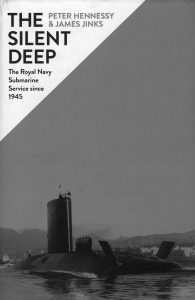- Author
- Book reviewer
- Subjects
- Book reviews, History - Between the wars, Royal Navy, Submarines
- Tags
-
- RAN Ships
- None noted.
- Publication
- December 2016 edition of the Naval Historical Review (all rights reserved)
By Peter Hennessy and James Jinks, Publishers Allen Lane, 2015, Hardcover & Paperback, 864 pages. RRP from $30.
 To many people the submarine is a mystery – what do they do and why do we need them? The popular perception is often aligned to the role of the submarine in World War IIwhere they played such a dramatic role in anti-ship warfare on both sides. The decades after WWIIsaw the development of the nuclear submarine with high underwater speed and endurance limited only by the submarine’s capacity to sustain her crew. Nuclear deterrence has become a submarine role with ballistic-missile equipped submarines haunting the ocean deeps with nuclear attack submarines seeking to track and shadow them.
To many people the submarine is a mystery – what do they do and why do we need them? The popular perception is often aligned to the role of the submarine in World War IIwhere they played such a dramatic role in anti-ship warfare on both sides. The decades after WWIIsaw the development of the nuclear submarine with high underwater speed and endurance limited only by the submarine’s capacity to sustain her crew. Nuclear deterrence has become a submarine role with ballistic-missile equipped submarines haunting the ocean deeps with nuclear attack submarines seeking to track and shadow them.
The story of the Royal Navy submarine service through this era is grippingly told in this new book by Peter Hennessy and James Jinks. The authors remind the reader that their book is not an official or an authorised history of the RN submarine service but one which has been written with unprecedented access to documents, personnel and submarines which enabled them to tell the story of RN submarines in considerable detail.
For two decades after WWIIthe RN stationed a number of submarines in Australia to help with the training of RAN and RNZN ships in anti-submarine warfare. Amongst those boats were HM Submarines Tabardand Taciturn. Few would have known of these boats’ involvement in the Cold War covert intelligence gathering operations in which they were engaged before coming to Australia which are described in this book, some of which are only known of by operation names as the reports remain secret even today. Intelligence, surveillance and reconnaissance are primary roles of the modern submarine and are a recurring story throughout the book.
The visit of the US Navy’s first nuclear submarine, USS Nautilus, to Britain in 1957 demonstrated to the Royal Navy the advantages of this revolutionary craft and the need for the RN to have such boats was made very clear. For Britain to proceed alone with the development of such submarines much time would have passed before a British nuclear submarine could be at sea — cooperation with the United States was the practical path to follow.
The US Navy’s nuclear submarine program was driven by that remarkable man, Admiral Hyman G. Rickover, the head of the US Naval Reactor Division. Rickover was reluctant to help the British, fearing that it would interfere with the US program but fortunately he developed a special relationship with Lord Louis Mountbatten which paved the way for an agreement to cooperate on the development of military nuclear reactors.
Britain’s first nuclear submarine, HMS Dreadnought, built by Vickers at Barrow-in-Furness and completed in 1962, was a hybrid design with a US power plant. The first nuclear submarine to have a British nuclear plant was HMS Valiant, ordered from Vickers in August 1960. The RN’s transition to nuclear power was soon followed by the program to build four submarines to carry the British nuclear deterrent — the Polaris submarines, Resolution, Renown, Repulseand Revenge. That program was controversial, costly and full of challenge.
The stories of Britain’s submarines during the Cold War, the challenge of keeping the nuclear deterrent at sea with the transition from Polaris to Trident and the actions of the submarines Falklands War of 1982 make fascinating reading. The problems which Britain has faced in recent years with the design and construction of the latest class of British nuclear submarine, the Astute-class, also provide many lessons for those facing major programs such as these. The Silent Deepis recommended for anyone with an interest in submarines and their operations.
Reviewed by John Jeremy




